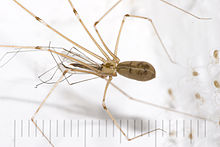
The Pholcidae are a family of araneomorph spiders. The family contains more than 1,800 individual species of pholcids, including those commonly known as cellar spider, daddy long-legs spider, carpenter spider, daddy long-legger, vibrating spider, gyrating spider, long daddy, and skull spider. The family, first described by Carl Ludwig Koch in 1850, is divided into 94 genera.

Solifugae is an order of animals in the class Arachnida known variously as camel spiders, wind scorpions, sun spiders, or solifuges. The order includes more than 1,000 described species in about 147 genera. Despite the common names, they are neither true scorpions nor true spiders. Most species of Solifugae live in dry climates and feed opportunistically on ground-dwelling arthropods and other small animals. The largest species grow to a length of 12–15 cm (5–6 in), including legs. A number of urban legends exaggerate the size and speed of the Solifugae, and their potential danger to humans, which is negligible.
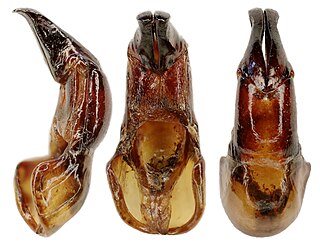
An aedeagus is a reproductive organ of male arthropods through which they secrete sperm from the testes during copulation with a female. It can be thought of as the insect equivalent of a mammal's penis, though the comparison is fairly loose given the greater complexity of insect reproduction. The term is derived from Ancient Greek αἰδοῖα and ἀγός. It is pronounced or.

Portia labiata is a jumping spider found in Sri Lanka, India, southern China, Burma (Myanmar), Malaysia, Singapore, Java, Sumatra and the Philippines. In this medium-sized jumping spider, the front part is orange-brown and the back part is brownish. The conspicuous main eyes provide vision more acute than a cat's during the day and 10 times more acute than a dragonfly's, and this is essential in P. labiata′s navigation, hunting and mating.
Spider behavior refers to the range of behaviors and activities performed by spiders. Spiders are air-breathing arthropods that have eight legs and chelicerae with fangs that inject venom. They are the largest order of arachnids and rank seventh in total species diversity among all other groups of organisms which is reflected in their large diversity of behavior.

The anatomy of spiders includes many characteristics shared with other arachnids. These characteristics include bodies divided into two tagmata, eight jointed legs, no wings or antennae, the presence of chelicerae and pedipalps, simple eyes, and an exoskeleton, which is periodically shed.
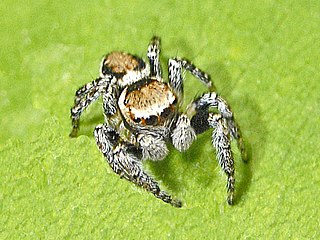
Evarcha falcata is a species of 'jumping spiders' belonging to the family Salticidae.

Sexual cannibalism is when an animal, usually the female, cannibalizes its mate prior to, during, or after copulation. It is a trait observed in many arachnid orders, several insect and crustacean clades, gastropods, and some snake species. Several hypotheses to explain this seemingly paradoxical behavior have been proposed. The adaptive foraging hypothesis, aggressive spillover hypothesis and mistaken identity hypothesis are among the proposed hypotheses to explain how sexual cannibalism evolved. This behavior is believed to have evolved as a manifestation of sexual conflict, occurring when the reproductive interests of males and females differ. In many species that exhibit sexual cannibalism, the female consumes the male upon detection. Females of cannibalistic species are generally hostile and unwilling to mate; thus many males of these species have developed adaptive behaviors to counteract female aggression.

Tarantulas comprise a group of large and often hairy spiders of the family Theraphosidae. As of December 2023, 1,100 species have been identified, with 166 genera. The term "tarantula" is usually used to describe members of the family Theraphosidae, although many other members of the same infraorder (Mygalomorphae) are commonly referred to as "tarantulas" or "false tarantulas". Some of the more common species have become popular in the exotic pet trade. Many New World species kept as pets have setae known as urticating hairs that can cause irritation to the skin, and in extreme cases, cause damage to the eyes.

Spiders are air-breathing arthropods that have eight limbs, chelicerae with fangs generally able to inject venom, and spinnerets that extrude silk. They are the largest order of arachnids and rank seventh in total species diversity among all orders of organisms. Spiders are found worldwide on every continent except Antarctica, and have become established in nearly every land habitat. As of November 2023, 51,673 spider species in 136 families have been recorded by taxonomists. However, there has been debate among scientists about how families should be classified, with over 20 different classifications proposed since 1900.

Psalmopoeus irminia, also known as the Venezuelan suntiger, is a species of tarantula endemic to Venezuela, Guyana and Brazil. They were first described in 1994 by F. Saager.
This glossary describes the terms used in formal descriptions of spiders; where applicable these terms are used in describing other arachnids.
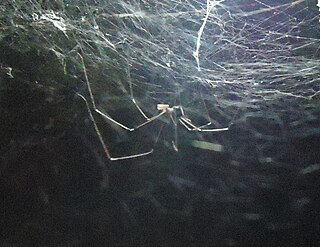
Crossopriza lyoni is a widespread species of cellar spiders that prefer to live in or around human structures. They are commonly known as tailed cellar spiders, tailed daddy longlegs spiders, and sometimes box spiders. They all possess extremely long fragile legs that can reach up to 6 cm (2.4 in) long and a body length of that ranges from 2.5 to 7 mm. Their abdomens are distinctly squarish when viewed from the side and their carapace is more or less circular when viewed from above. They also possess two kinds of sound-producing organs and have six eyes.
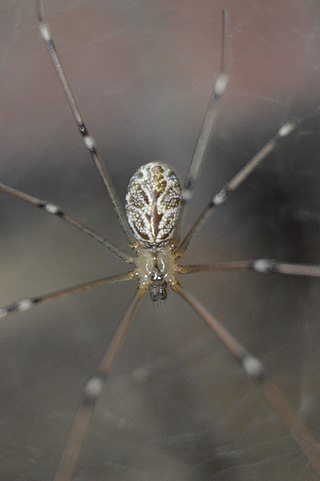
Holocnemus pluchei, commonly known as the marbled cellar spider, is a species of Pholcidae, a family commonly referred to as "cellar spiders" or "daddy long-legs". This species is distributed across the North Pacific region of the United States, as well as in parts of North Africa, Europe, and the Mediterranean. It is considered a common household spider and builds its nest in attics, basements, and eaves of houses. Although some members of the species live in solitary webs, the majority join already existing webs and migrate to new webs multiple times throughout the course of their lives. A unique feature of H. pluchei is that while in many species of spiders, stridulation commonly occurs by males during sexual encounters, in H. pluchei, females also possess stridulatory organs, and both sexes engage in stridulation.

Cyclosa argenteoalba, in the trashline orbweavers genus, is a species of orb weaver in the spider family Araneidae. It is found in East Asia in the countries of China, Japan, and Korea. C. argenteoalba are diurnal, which means they are active during the day. Each individual has a unique appearance due to their differences in the ratio of black to silver coloring on their abdomen. Spiders with less silver coloring are better at catching prey, since the silver is bright and warns their prey. They catch their prey by waiting in the hub of their web until their prey is close enough to catch. Parasitic larvae are often found attached to C. argenteoalba, and the larvae are able to manipulate the spider's behavior. Females are on average 2 mm longer in size than males. During mating, female genital mutilation is common in order to increase the fitness of the male. On their webs, they often attach silk "decorations" that are thought to deter predators. Relocating to a different place to build a new web occurs frequently until they find a location with a significant amount of prey.

Panjange is a genus of leaf-dwelling spiders in the family Pholcidae, widely distributed in the islands of Southeast Asia from Borneo and the Philippines to northern Australia. Panjange spiders exhibit some of the most extraordinary morphology among Pholcidae. Males of most species have eye stalks, sometimes with long pointed processes; males of some species have unusually elongated pedipalps, which in spiders function as copulatory organs; and females of some species have external portions of their genitalia strongly folded and extensible. The biological significance of these sexual modifications remain unclear.
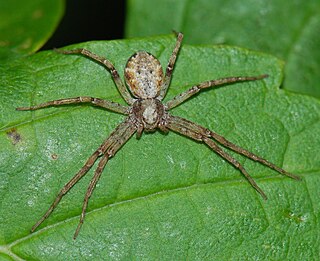
Philodromus cespitum is a species of running crab spider in the family Philodromidae. It is found in North America, Europe, North Africa, and parts of the Middle East and Asia. P. cespitum is a foliage-dweller, and is the most abundant species found in European fruit orchards. It acts as a biological control by preying on orchard pests. P. cespitum is a diurnal ambush hunter and preys on aphids, insects, and occasionally competitor spider species. Males court females by tapping on the females’ bodies with their forelegs. They then insert a genital plug into the female during copulation. Unlike in many other spider species, subsequent males can mate with plugged females by removing part of the plug prior to copulation. Males discriminate among females based on virginity and plug size, and can determine these factors using the females’ draglines and plug samples.
Agelenopsis pennsylvanica, commonly known as the Pennsylvania funnel-web spider or the Pennsylvania grass spider, is a species of spider in the family Agelenidae. The common name comes from the place that it was described, Pennsylvania, and the funnel shape of its web. Its closest relative is Agelenopsis potteri.
Muruta is a small genus of southeast Asian cellar spiders named after the Murut people. It was erected in 2018 for two species transferred from Pholcus after a molecular phylogenetic study of Pholcidae. They are average size for cellar spiders with relatively long legs, the first legs averaging 35 to 40 millimetres long. Males can be distinguished from other species by hairless, flat sclerites on their chelicerae, and females can be distinguished by three-layered telescopic tubes in their genital structure. As of April 2022 it contains only two species, both native to northern Borneo: M. bario and M. tambunan.

Leucauge mariana is a long-jawed orb weaver spider, native to Central America and South America. Its web building and sexual behavior have been studied extensively. Males perform several kinds of courtship behavior to induce females to copulate and to use their sperm.
